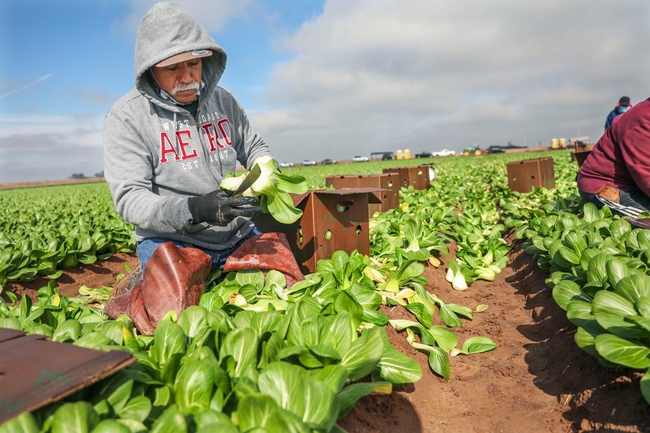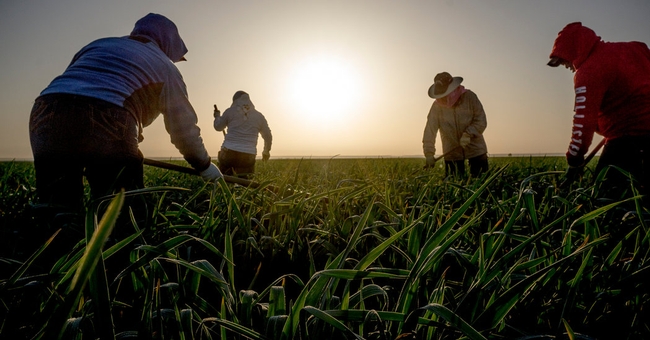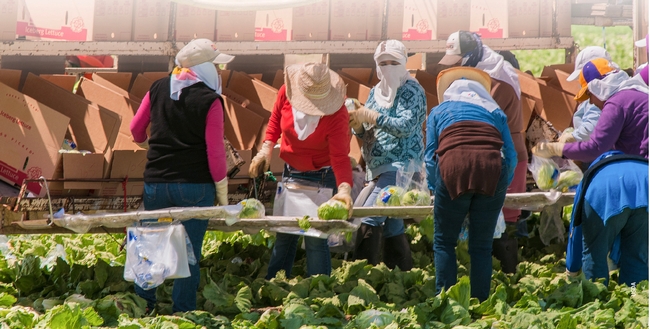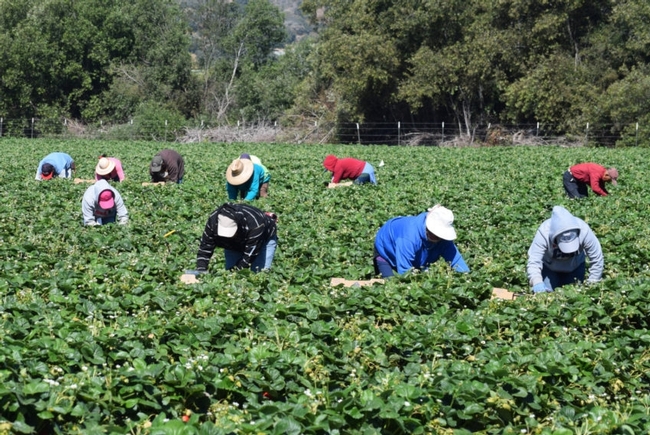- Author: Ricardo A. Vela
The death of a farmworker on May 14, 2005, east of Stockton, California, highlighted the sufferings of day laborers during the summer. María Isabel Vásquez Jiménez, originally from Oaxaca, Mexico, 17 years old and two months pregnant, worked in a vineyard in temperatures above 95 degrees. Her death and that of three other day laborers in previous years led California to adopt the law requiring shade, water and rest to prevent more deaths due to heat stroke.
Teresa Andrews, a community educator at the Western Center for Agricultural Health and Safety at the University of California, Davis, remembers when scientific studies were being done to support the law.
"The study was specifically about how heat affects people,” Andrews said. “There was a group of experts who were visiting various agricultural sites, from Northern California to the border with Mexicali, and were looking at the different tasks that the workers did during the day. This study was done for three years in the summer season."
At the same time, scientists collected data on ambient temperature, humidity and other environmental factors.
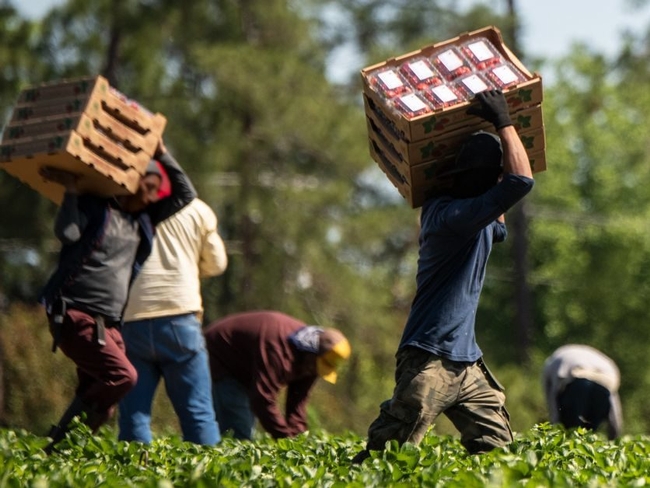
The study revealed that even though most of the workers were under 40 years of age, by the end of the day, most of them were dehydrated. When a person is dehydrated, they are exposed to several health problems, including death.
"When the study was going to start, the death of a young farmworker, María Isabel Vásquez-Jiménez, was recorded, and this led Cal/OSHA to start the campaign of shade, water and rest," Andrews said. She adds that the center was an essential part of this campaign since its inception 17 years ago.
Since the initiative was signed into law in 2005 by then-Gov, Arnold Schwarzenegger, every year during the summer, California Division of Occupational Safety and Health and the UC Davis Western Center for Health and Safety in Agriculture have resumed the campaign and offered workshops in Spanish and English throughout the state to raise awareness among workers of their right to receive shade, water and rest if they need it.
Despite these efforts, in the last 12 years, 24-day laborers have died due to heat illness.
"Sometimes when I talk to them directly during training, they tell me they don't drink water because they're afraid they're going to go to the bathroom a lot, that the employer is going to get their attention because they're not working as fast," Andrews says.
Having water for consumption is the right of day laborers. Andrews says drinking water in small amounts is crucial to the farmworker's well-being. She uses simple concepts in her workshops to make farmworkers aware of the importance of always being hydrated.
"We don't have a little light that warns us about the lack of water, but we are thirsty, which is the signal to know that we are close to suffering from heat illness or heat stroke," says Andrews.
The community educator emphasizes the difference between heat exhaustion and heat stroke.
Heat exhaustion is caused when the body loses excessive amounts of water and salt, while in the potentially fatal heat stroke, the body cannot control its internal temperature. Heat stroke is a medical emergency.
The warning signs for heat exhaustion are as follows:
- Fever above 104 degrees Fahrenheit.
- Changes in mental state or behavior include confusion, agitation, and babbling.
- Hot, dry skin or excessive sweating.
- Nausea and vomiting.
- Reddened skin.
- Accelerated pulse.
- Rapid breathing
Symptoms of Insolation/Heat Stroke are:
- Confusion
- Convulsions.
- Fainting.
- Feeling thirsty.
- Intermittent muscle cramps in the extremities and abdomen.
- In insolation, abundant sweating occurs; in heat stroke, sweating ceases, and the skin is dry, hot, and red.
- Dizziness, nausea, and vomiting.
- Strong and irregular pulse.
- Rapid, noisy breathing.
- Body temperature is high.
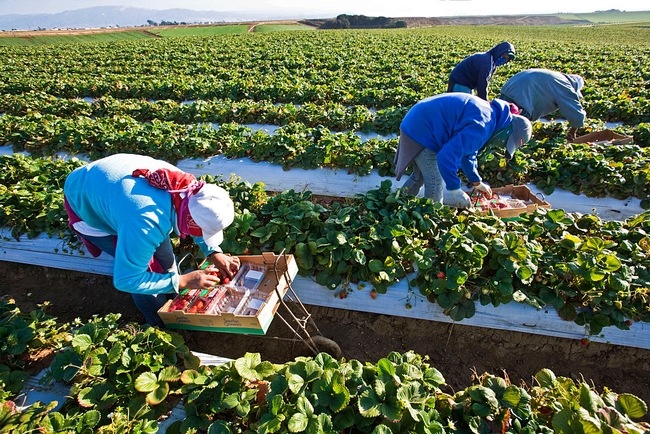
According to data from Cal/OSHA, every year, at least three or four farmworkers die due to heat stroke.
"People get used to hearing science-based information, and it's meant to help them lead a better quality of life," Andrews says.
The work to create awareness that the Western Center for Agricultural Health and Safety, CalOsha, and UC ANR are doing is critical because the threat of heat stroke is increasing as temperatures climb higher every summer. The study, published last month in the journal Geophysical Research, found that climate change is making summers hotter and longer while reducing the other three seasons. The average summer temperature over the past five years has been 1.7 degrees warmer than it was from 1971 to 2000.
Over 1 million farmworkers work under extreme heat each day. During peak production seasons, July and August, workers are in the fields for 12 hours or more, in temperatures that frequently exceed 100 degrees.
Other resources:
https://safety.ucanr.edu/Programs/Heat_Illness_Prevention/
https://ucanr.edu/news/?uid=691&ds=191
https://ucanr.edu/sites/ucanr/News/Heat/Heat_illness_symptoms_and_first_aid/
- Author: Norma De la Vega
- Adapted to English by: Ricardo A. Vela
Today, amid a pandemia-battered labor market and a deep crisis across the food industry chain, it is crucial to reduce barriers to employment and pay attention to the problem of sexual harassment. This problem occurs most often in low-paying, male-dominated jobs such as agriculture.
Recent research from the Division of Agriculture and Natural Resources at the University of California UC ANR found that 30 percent of female workers at nine wine industry companies in Napa Valley reported some form of sexual harassment at their current job. They are young women under the age of 40, several temporary employees who usually work in small groups throughout the camp where sexist and hostile jokes and comments are frequently heard.

- Sexual harassment in agriculture is a historically neglected problem that is gaining economic relevance in the current context of agriculture, an industry dealing with labor shortages.
- The lack of a workforce is a severe problem, considered by several experts as the main challenge in food production.
- The shortage of male migrant workers would be even worse without increasing the female workforce.
"Women need to feel safe to be productive, and with the critical lack of labor in agriculture, this industry needs to make sure it retains these workers," Hobbs said.
Research indicates that between 40 and 75 percent of all working women in this country have experienced some form of sexual harassment, and this has not decreased since the 1980s. Even worse, the problem often occurs in low-paying jobs that men dominate.
Sexual harassment is unwanted behavior that the victim perceives as offensive that threatens their well-being. "It's a barrier that not only harms the victim but other workers at the company, and I should add that sexual harassment is not something that happens only to women but also to men, but this was not the focus of our study," Hobbs said.
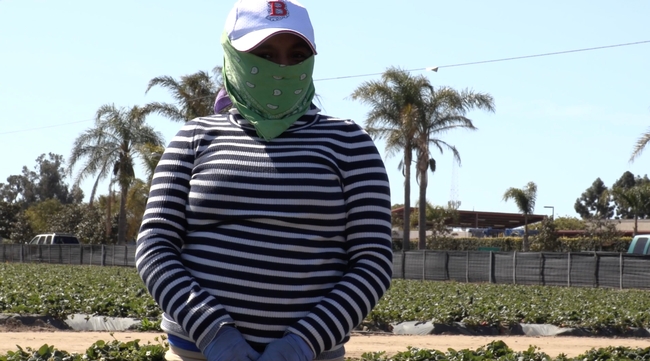
- Gender-based harassment – jokes, comments, or suggestive stories that are offensive, or different treatment for being a woman (contempt or ignoring the woman)
- Unwanted sexual attention – requesting a date or inviting drinks even though you were told NO. Touching or groping the person.
- Sexual coercion – bribing the employee in exchange for engaging in sexual behavior (offering a promotion in exchange for a sexual favor)
- Hostile Sexism - comments or acts that are interpreted by women as sexist (for example: "Women are easily offended"; "women do not appreciate everything that men do for them"; "Women exaggerate the problems they have at work."
In agriculture, labor shortages are not a new problem. Since before the pandemic, they have been present and have been reduced thanks to the increase in women workers.
In 2017, Napa Valley vineyards employing an average of 100,000 workers had a shortage of 12 percent workers, and this would have been worse without the workers. "More women are working than there were 20 years ago, and this change in the gender of workers that I describe in Napa is also happening to some degree on the California Coast," he says.
The research highlights that between 2013 and 2016, the proportion of working women increased in Napa Valley vineyards from 10 to 25 percent.
"The economic motivation is, therefore, stronger than ever for agricultural companies to reduce barriers to employment and retain female workers, and sexual harassment in the workplace is a barrier to employment," Hobbs says. These women are indispensable to fill the vacancies that used to be filled by immigrant workers that have declined in recent years."
The research involved 195 men and 100 women, all Hispanics. The nine companies surveyed have more than 50 employees each; in seven of them, subcontracted labor is used, and in 2 vineyards, their employees are directly employed. The survey was conducted in English and Spanish. Of the 30 percent of women who reported experiencing sexual harassment, 9 percent said unwanted sexual attention and 1 percent sexual coercion.
"The fact that harassment is more prevalent among young women is an indicator that harassment is an obstacle to expanding the workforce because they are women who are starting to work," he said.
He explained that the relatively low percentage of sexual harassment found in this research compared to other research could be because the wine industry usually offers better wages and better working conditions than other workplaces.
Hobbs concludes that this research is an approach to a complex labor problem that requires more attention, and possibly the next step will be to analyze the overall work environment, addressing the hostile sexist attitudes of workers and evaluating the entire organization, which seems to be the most promising thing to reduce harassment in agriculture. "The conditions in which the workers are currently working makes them more vulnerable, the training help, but there are changes that must be executed. Changes have to be made throughout the organization," concluded the expert.
Additional resources:
This investigation was carried out thanks to the collaboration of the Western Center for Agricultural Health and Safety at the University of California, Davis, offers all kinds of training on agricultural safety. An integral part of this report was a podcast where Teresa Andrews, the Center's Education and Community Outreach Specialist, talks extensively about what harassment is, what the law says about harassment, and what to do when you have been bullied. Here's the link to the podcast.
- Author: Ricardo Vela
Agricultural workers have not stopped working since they were deemed essential at the start of the pandemic. They have continued to plant, harvest, and process the nation's food during the crisis as well as during devastating fires.
"They should give us wage support in agriculture. We expose ourselves every day to this virus, and we're not lucky enough to be able to work from home. It can't be harvested from a computer, said Martin, a 49-year-old farmworker from Southern California.
The lack of an adequate response from employers and the federal government has made agricultural workers feel used and abused, and doubly struck by the crisis. They claim that the government's lack of response has left them vulnerable to various health problems: Eliseo, a 40-year-old agricultural worker from the San Joaquin Valley, commented, "We're supposed to be indispensable and essential, but we don't seem to be essential -- like we're useless garbage you can throw away, and then they're going to hire more people. That's how I feel."
California's eight hundred thousand agricultural workers have been struck hard by COVID-19. Clara, a 53-year-old farmworker from the San Joaquin Valley, explained, "Things have changed drastically because we had to stop working. Because there hadn't been a good job as there would have been. Sometimes they wouldn't let us come to work because they didn't want a lot of people."
The phase two of the COVID-19 Pandemic report , (COFS) conducted by Bonnie Bade, PhD; Sarah Ramirez, PhD, MPH; Dvera I. Saxton, PhD. Made public on February 2nd, 2021, shows how the pandemic has worsened the economic vulnerabilities and fragility within the food system and increased disparities in insecurity, risk, and health for agricultural workers and their families. Clara's family is one of the affected
"We were out of work for almost two months. God only knows how we survived it because we don't even understand. We survived with the help of God and friends who gave us food,” she said.
The report states that agricultural workers need to continue working because of food and job insecurity, even while they are sick. Those who are unable to work cannot afford to take many days off for fear of not having enough money to pay rent and bring food to their families.
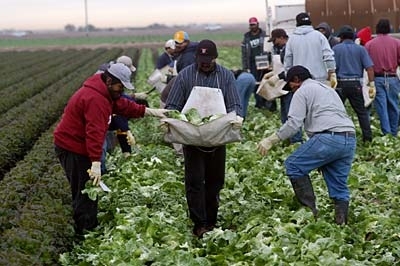
The conditions under which they carry out their work and transportation are two of the high-risk factors for agricultural workers to contract COVID-19. They often travel to the fields in large, overcrowded groups in a truck. And at work, all of them take their rest under a tent, without following health measures such as social distancing or mouth coverings. Pedro, a 45-year-old farmworker from the desert region, explained, "The concern is that we are full in transport. At lunch, they set up a 4x8 tent [to provide shade]. The foreman yells at us that the work must continue and that he doesn't care if one has COVID-19 or not. They don't even wear masks. The chief kept quiet and didn't tell anyone until some of them died."
During surveys conducted in the investigation of field workers' conditions, the farmworkers denounced the inconsistent implementation of public health policy in agricultural workplaces. The report adds that the government did not recognize their concerns about workplace safety or, in some cases, they were openly dismissed and mocked by employers, supervisors, and government agencies responsible for protecting workers' health.
Eliseo, an agricultural worker from the San Joaquin Valley, testified, "We reported that they [bosses] didn't give us face masks. In other words, we asked them for face masks, and they just laughed. And we ordered soap to wash our hands because there were so many places where we couldn't wash our hands, and they just laughed. And several of my co-workers and I called Cal/OSHA, and we got together to call for help before we could get infected. And they [Cal/OSHA] told us they were going to send letters and they were going to talk to our boss, but they never did anything."
The mental health of agricultural workers and their families during the pandemic is another major concern shown in the report. Their main anxieties are the fear of getting sick or infecting others, losing income and jobs, and being evicted from their homes. Marcos, a 45-year-old farmworker from the San Joaquin Valley, explained, "If we don't work, we don't pay bills, we don't buy food, we don't pay the rent, and then where are we going to live?"
Eduardo, a 31-year-old agricultural worker also from the San Joaquin Valley, said, "I'm afraid to get sick, but what keeps me awake at night is the idea that I'm infectious but symptomless, and it makes me think maybe it's my fault they closed our workplace because I infected all my friends. That's a big fear that invades my thoughts."
The lack of social support networks, including extended family, churches, and other community spaces that have been limited for farmworkers, has harmed these communities as it has done for the rest of the population.
On testing and vaccination, the report notes that the spread of misinformation due to conspiracy theories and the lack of vision of government agencies to offer agricultural workers evidence at nearby sites has created a high mistrust among these families. For indigenous language speakers, not understanding where to test, how to test, and interpreting and acting on the results was even more frustrating. Lupe, a 30-year-old Oaxacan farmworker from Southern California, said, "We don't know, or we don't go. We haven't been to do the coronavirus test because we don't know where to go. If they give it to us, we'll go because we don't know where to go."
As for vaccines, the study shows that side effects are a great fear. Simultaneously, a smaller percentage of males reported not being interested in getting vaccinated for fear of being microchip implanted, while women were reluctant to get vaccinated for fear of becoming infertile. 12% showed a distrust of the government.
The coalition of community organizations and universities recommends creating a culture of equity for field workers.
- As essential workers in national and global food systems, policies should include food and agricultural workers in all financial assistance and aid programs at the federal, state, county, and municipal levels, regardless of their immigration status.
- During school closures, there must be ongoing financial assistance for families with at least one adult staying at home or forced to stay home due to reduced hours, illnesses, temporary closures, staff reductions, or layoffs.
- Creation of culturally and linguistically appropriate places of communication for agricultural workers, such as regionally organized telephone lines, attended by persons in that community, during hours favorable to these workers, to report on violations of the COVID-19 protocol and other breaches of the protocol related to work in times of pandemic.
- In pandemic and ordinary circumstances, public health and occupational health and safety messages should remain clear and consistent in this regard. Messaging must be relevant for language and culture, but it must also come from trusted sources in the community.
- Expansion of testing and vaccination efforts in rural communities. Agricultural workers will benefit from appointment sites for free trials in places near their homes or workplaces.
- Agricultural workers should be included and represented in the design and dissemination of each and every public health campaign aimed at them. Agricultural workplaces should appoint field workers to serve as health and safety ambassadors, offering them a higher salary.

